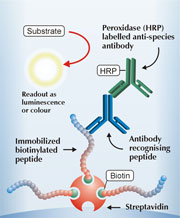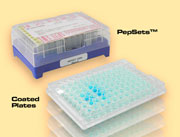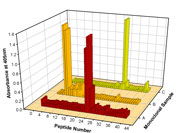Antibody Epitope Mapping using Biotinylated PepSets
|
|||||
|
|
Linear antibody epitopes are readily mapped with PepSets. Sets of overlapping peptides from potential target vaccine proteins are screened with immune sera or cells to find vaccine or diagnostic test candidates. This saves years of expensive “trial and error” research based on predictive methods.
Antibody epitope mapping by ELISA is simple to perform using biotinylated peptides because the peptides can be captured onto Streptavidin™ or NeutrAvidin™ coated plates through the strong noncovalent avidin-biotin binding. Probing the wells with antibody and washing away unbound antibodies quickly reveals those peptides to which the antibody has bound. For simplicity of reagents, an indirect ELISA is usually preferred so that a common enzyme-labelled reagent can be used for all tests (Figure 1).
|
Example: Screening of Monoclonal Antibodies
In a typical example, a library of monoclonal antibodies to a small protein, thought to recognize linear epitopes, was screened using a PepSet of biotinylated peptides (Figure 2). The set consisted of short overlapping peptides derived from the protein being investigated and the peptides were captured onto plate wells coated with streptavidin before completing an ELISA with each monoclonal antibody (Figure 1). Using this approach, the linear epitopes of several monoclonal antibodies were quickly and clearly identified. The monoclonal antibodies fell into groups recognizing one of three linear sequences of the protein. One example from each group is shown in Figure 3.
Advantages of Biotinylated PepSets for Mapping
PepSets have several advantages over other screening methods such as noncleaved peptides and blots. These are summarized in the following table.
|
||
|
| Advantage | Explanation |
| High throughput | Simultaneous parallel testing of all the antibodies for immediate results |
| No re-probing | All tests are performed with new peptide |
| Quantitative data | OD readings from a standard lab plate reader, versus image analysis etc. |
| Lower backgrounds | When compared with membrane- or card-bound peptide |
| Minimal steric hindrance to binding | Due to the spacer incorporated between the biotin and the peptide1 |
| Essentially unlimited numbers of tests from one PepSet | The 1-3mg scale PepSet is enough peptide for several thousand ELISA tests. |
Customer Service and User-friendly Products
Custom synthesized biotinylated PepSets for linear antibody mapping are designed by the research scientist with help from experienced Technical Consultants at Mimotopes, and are shipped either ready to redissolve and plate or as ready-to-use plates already coated with the peptide (Figure 2).
Other Powerful PepSets Applications
T-cell epitopes (Helper and Cytotoxic) are easily located using PepSets provided peptides of the correct length are used2. This application is summarized in a separate article entitled Truncated Peptide Libraries for Cytotoxic T-Cell Epitope Mapping, available on the Mimotopes website. When a bioactive sequence is already known, analoging studies can be carried out using the set of peptides comprising single-point substitution sequences, or a combination of 2 or more selected substitutions. Sequences exhibiting enhanced bioactivity, or inhibitory properties, are candidates for development as peptide or peptidomimetic drugs.
References
- Weiner, A. J., Geysen, H. M., et al. (1992) Evidence for immune selection of hepatitis C virus (HCV) putative envelope glycoprotein variants: Potential role in chronic HCV infections. Proc. Natl. Acad. Sci. USA 89; 3468-3472.
- Rodda, S.J. (2002) Peptide Libraries for T-Cell Epitope Screening and Characterization. J. Immunological Methods, 267, 71-77.






